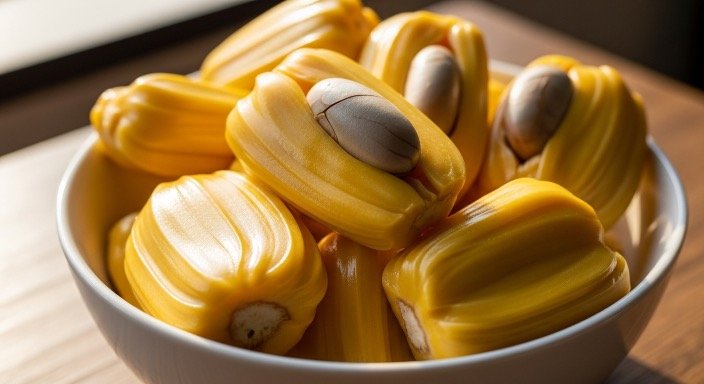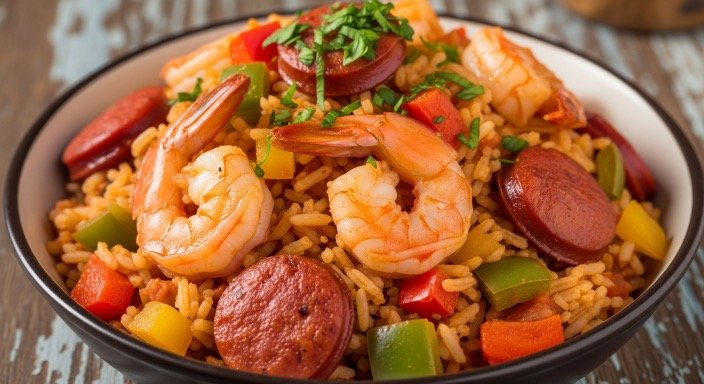When it comes to foods that start with J, you’re in for a journey filled with juicy flavors, joyful dishes, and just a touch of global adventure. From the tropical sweetness of jackfruit to the fiery kick of jalapeños, and from comfort classics like jambalaya to refreshing drinks like jasmine tea, this letter truly brings the world to your plate.
What makes “J” foods special is their incredible variety. They cross continents — Japanese noodles, Jamaican jerk chicken, and Jordan almonds — all showing how cuisine connects cultures through creativity and flavor. Whether you love fruits, grains, seafood, or spices, this alphabet stop has a little bit of everything.
Reference: The World Health Organization emphasizes that dietary variety is key to maintaining long-term wellness and preventing nutrient deficiencies.
Quick-Reference Table: Foods That Start With “J”
| Category | Foods That Start With J |
| Fruits | Jackfruit, Jabuticaba, Jujube, Juneberry, Java Plum |
| Vegetables | Jalapeño, Jicama, Jerusalem Artichoke, Japanese Eggplant |
| Grains & Seeds | Jasmine Rice, Job’s Tears (Adlay), Japanese Rice |
| Beans & Legumes | Jack Bean, Japanese Soybean (Edamame) |
| Nuts & Oils | Juglans (Walnut Genus), Juniper Oil (from berries) |
| Meats & Poultry | Jerk Chicken, Jamón (Spanish Ham), Jellied Meat |
| Seafood | John Dory, Jellyfish (edible form), Japanese Eel (Unagi) |
| Dairy & Cheese | Jarlsberg Cheese, Jameed (fermented yogurt) |
| Spices & Herbs | Juniper Berry, Japanese Parsley (Mitsuba) |
| Condiments & Sauces | Japanese Soy Sauce, Jerk Marinade, Jam |
| Beverages | Jasmine Tea, Juice (varieties), Julep, Jaggery Drink |
| International Dishes & Desserts | Jambalaya, Jollof Rice, Jelly, Jalebi, Jordan Almonds |
Foods that start with J
Alphabetical List & Descriptions
1. Jabuticaba (Fruit)
A rare Brazilian fruit that grows directly on tree trunks, jabuticaba looks like a dark grape but tastes sweeter with a hint of acidity. It’s often made into jams, jellies, or wine.
Reference: Harvard Health notes its high antioxidant and anti-inflammatory properties.
2. Jack Bean (Legume / Protein)
This large tropical bean is used in animal feed and, when cooked properly, in certain regional cuisines. It’s high in protein and fiber but must be thoroughly cooked to remove toxins.
3. Jackfruit (Fruit / Meat Substitute)
Foods that start with J

Foods that start with J
Native to South and Southeast Asia, jackfruit is the world’s largest tree fruit. When ripe, it’s sweet and tropical; when unripe, it becomes a popular vegan meat substitute due to its fibrous texture.
Reference: NIH highlights jackfruit’s versatility and nutrient profile.)
4. Jaggery (Sweetener / Condiment)
A traditional, unrefined sugar made from cane juice or palm sap. Jaggery retains minerals like iron and magnesium, unlike white sugar, and adds a deep caramel flavor to sweets and drinks.
Reference: Science Direct explains jaggery’s trace minerals and cultural use.)
5. Jalapeño (Vegetable / Spice)
One of the most recognizable chili peppers, jalapeños add heat and tang to salsas, sauces, and pickles. Rich in vitamin C and capsaicin, they support metabolism and antioxidant defense.
6. Jambalaya (Dish / Rice / Protein)
Foods that start with J

Foods that start with J
A beloved Creole dish from Louisiana that combines rice, sausage, shrimp, and spices. It’s hearty, aromatic, and reflects the blend of African, French, and Spanish cuisines.
Reference: Britannica outlines its multicultural origins.)
7. Jam (Condiment / Spread)
Made by cooking fruit with sugar until thickened, jam preserves fruit flavors for long-term use. Common in breakfasts and desserts, it adds sweetness and texture to dishes.
8. Jamón (Meat / Pork)
Spanish dry-cured ham, especially the famous Jamón Ibérico, is prized for its nutty flavor and silky texture. It’s aged for months and enjoyed thinly sliced.
9. Jarlsberg Cheese (Dairy / Cheese)
A mild, nutty cheese from Norway with holes like Swiss. Excellent for melting or pairing with fruit and crackers.
Reference: Cheese.com describes its semi-soft texture and global appeal.)
10. Jasmine Rice (Grain / Staple)
A fragrant, long-grain rice variety from Thailand, known for its floral aroma and slightly sticky texture. Ideal for curries, stir-fries, and Asian-inspired dishes.
11. Jasmine Tea (Beverage / Herbal)
A soothing tea scented with jasmine blossoms. Light, aromatic, and rich in antioxidants, it promotes relaxation and digestive health.
Reference: WebMD notes its calming and antioxidant properties.
12. Japanese Eggplant (Vegetable)
Slimmer and sweeter than traditional eggplant, this variety cooks faster and absorbs flavors beautifully. Great for grilling, stir-frying, or roasting.
13. Japanese Eel (Seafood / Protein)
Known as unagi in Japanese cuisine, grilled eel is glazed with soy-based sauce and served over rice. It’s rich in omega-3 fatty acids and vitamin A.
14. Japanese Parsley (Herb)
Called mitsuba in Japan, this aromatic herb has a mild celery-like flavor. Commonly used in soups, sushi, and tempura.
15. Japanese Rice (Grain)
Short-grain sticky rice used in sushi and traditional meals. It provides quick energy and a soft, glossy texture.
16. Jellied Meat (Meat / Appetizer)
A traditional European dish where cooked meat is set in gelatin. Though less common today, it’s part of culinary heritage in Eastern Europe.
17. Jelly (Dessert / Condiment)
Made from fruit juice and pectin, jelly is smoother than jam and often served with bread or pastries. It can also be used in desserts or sauces.
18. Jellyfish (Seafood / Delicacy)
Prepared for texture rather than flavor, jellyfish is a delicacy in some Asian cuisines. It’s low in calories and often served cold with sesame oil and vinegar.
19. Jerk Chicken (Meat / Poultry / Marinade)
A Jamaican classic marinated with allspice, thyme, and Scotch bonnet peppers. Grilled to smoky perfection, it delivers deep, spicy, and aromatic flavor.
Reference: BBC Good Food provides authentic preparation tips.
20. Job’s Tears (Grain / Cereal)
Also called adlay, this ancient grain from East Asia is rich in fiber and used in soups and porridges. Naturally gluten-free.
21. Jollof Rice (Dish / Grain / African Cuisine)
A West African favorite made with rice, tomatoes, and spices. Each region—Nigeria, Ghana, Senegal—adds its own twist.
22. Jordan Almonds (Dessert / Nut)
Candy-coated almonds traditionally served at weddings. The sugar coating symbolizes wishes for health and happiness.
23. Jujube (Fruit)
A small, red fruit that dries into a chewy, date-like snack. It’s rich in vitamin C and used in teas, desserts, and herbal medicine.
24. Juice (Beverage / Fruit Drink)
Natural fruit juice provides hydration and vitamins but should be consumed in moderation due to sugar content. Fresh-squeezed options offer the most nutrients.
25. Juniper Berry (Spice / Herb / Condiment)
Used to flavor gin and meats, juniper berries have a piney, resinous flavor. They’re high in antioxidants and aid digestion.
26. Julep (Beverage / Cocktail)
A refreshing drink traditionally made with bourbon, mint, and crushed ice. The mint julep is especially famous at the Kentucky Derby.
Foods that start with J
Health Benefits of J-Foods
- Jackfruit, jujube, and jabuticaba are antioxidant-rich fruits supporting immune health.
- Jasmine tea and juniper berries aid digestion and provide relaxation benefits.
- Jalapeños may improve metabolism due to capsaicin.
- Job’s tears deliver complex carbs and fiber for gut and heart health.
Reference: NIH confirms the role of antioxidants and fiber in chronic disease prevention.
Foods that start with J
Fun Facts
- “Jackfruit” trees can produce over 100 fruits a year, some weighing more than 80 pounds.
- The word “jambalaya” likely comes from the Provençal jambalaia, meaning “mix-up” — fitting for the dish’s colorful blend of ingredients.
- The first mint julep recipes date back to the early 1800s.
Foods that start with J
Final Thoughts: Joy in Every “J” Bite
The letter “J” brings a joyful mix of taste, texture, and tradition. From the exotic sweetness of jackfruit and jujube to the comforting warmth of jambalaya and jerk chicken, “J” foods are a reminder that eating well is both nourishing and fun. Whether you’re sipping jasmine tea or stirring a pot of Jollof rice, there’s flavor, history, and health in every bite.
Reference: Food Revolution suggests that exploring diverse ingredients like these ensures a wide range of vitamins and phytochemicals.
Next up: Continue your alphabetical food journey with Foods That Start With K — where kitchen creativity keeps growing!
